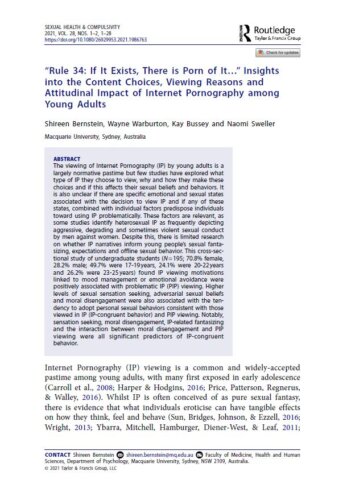Shaping Sexual Behaviors & Sexual Scripts
Rule 34: If it exists, there is porn of it…: Insights into the content choices, viewing reasons and attitudinal impact of internet pornography among young adults.
Open Access: No.
Abstract
The viewing of Internet Pornography (IP) by young adults is a largely normative pastime but few studies have explored what type of IP they choose to view, why and how they make these choices and if this affects their sexual beliefs and behaviors. It is also unclear if there are specific emotional and sexual states associated with the decision to view IP and if any of these states, combined with individual factors predispose individuals toward using IP problematically. These factors are relevant, as some studies identify heterosexual IP as frequently depicting aggressive, degrading and sometimes violent sexual conduct by men against women. Despite this, there is limited research on whether IP narratives inform young people’s sexual fantasizing, expectations and offline sexual behavior. This cross-sectional study of undergraduate students (N = 195; 70.8% female, 28.2% male; 49.7% were 17-19 years, 24.1% were 20-22 years and 26.2% were 23-25 years) found IP viewing motivations linked to mood management or emotional avoidance were positively associated with problematic IP (PIP) viewing. Higher levels of sexual sensation seeking, adversarial sexual beliefs and moral disengagement were also associated with the tendency to adopt personal sexual behaviors consistent with those viewed in IP (IP-congruent behavior) and PIP viewing. Notably, sensation seeking, moral disengagement, IP-related fantasizing and the interaction between moral disengagement and PIP viewing were all significant predictors of IP-congruent behavior.
Relevance
This study found that problematic internet pornography viewing (PIP) was “positively associated” with using pornography for “mood management or emotional avoidance” – that is, the “avoidance of emotional discomfort such as stress, fatigue, boredom and facilitating distraction. ” Other associations with PIP include “being under the effect of alcohol or illicit substances.”
Additionally, mirroring what one sees in internet pornography (“IP-congruent behavior”) was associated with a “cognitive bias” known as “moral disengagement.” This process of “dehumanization” and “sanitation” allows the pornography viewers to justify the “aggressive” and “degrading” attitudes towards women portrayed in pornography. One common – and dangerous – example in pornography is construing sexual violence as a ‘consensual fantasy,’ and so exempt from everyday morality. Another is by presenting women as “sexual body parts rather than as people.”
(Moral disengagement is defined as “cognitively restructuring inhumane conduct into benign conduct using mechanisms including moral justification, sanitizing language, advantageous comparison, displacement of responsibility, diffusion of responsibility, distortion of possible consequences, attribution of blame, and dehumanization.” Engaging in high moral disengagement “engenders less prosocial behavior and empathy and allows individuals to feel less guilt for their detrimental behavior toward others, both of which reduce restraints over aggressive acts.”)
This study agrees with previous research that “the desire for and participation in forceful sex acts including hair pulling, spanking, scratching, biting, bondage, fisting, and double penetration were common amongst individuals” who attuned their own sexual behaviors to what they see in pornography. They “morally disengage from the conduct depicted online and continue to fantasize about such behaviors without any apparent consequences…The capacity for moral disengagement has previously been implicated in a range of harmful acts and beliefs, including sexual aggression, interpersonal violence and rape myth acceptance.”
Citation
Bernstein, S., Warburton, W., Bussey, K., & Sweller, N. (2021). “Rule 34: If it exists, there is porn of it…” insights into the content choices, viewing reasons and attitudinal impact of internet pornography among young adults. Sexual Health & Compulsivity, 28(1-2), 1–28. https://doi.org/10.1080/26929953.2021.1986763

